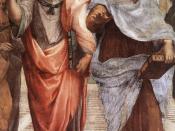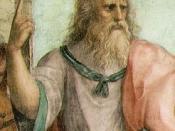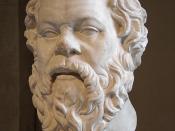Plato was a philosopher living in Athens during the Hellenistic period. He was an aristocrat, but did not venture into politics, instead having a love of philosophy instilled in him by his tutor, Socrates. Plato thought and taught philosophy his whole life, and unlike Socrates wrote his ideas down in the form of dialogues. One such work is the Republic, in which the analogy of the cave is expounded.
In the analogy of the cave, Plato describes prisoners (representing us) bound and fettered inside a cave such that they can see only the back wall. Behind them is a wall, behind which is a fire. People walk behind the wall, holding models above it such that the models project shadows onto the back wall of the cave. Shadows of the models and shadows of themselves are all the prisoners ever perceive, hence they come to believe that "the truth [is] literally nothing but the shadows" .
Because the fire flickers and the cave wall is rough, the shadows are only rough, constantly changing approximations to the models, which in turn are only rough approximations to their bearers. Therefore any conclusions drawn about reality by the prisoners are not grounded in true knowledge.
If it so a happens a prisoner is released from his bonds, he will look behind him and be dazzled by the fire. This is equivalent to a human beginning to question what he sees and takes at face value - the initial reaction is puzzlement and confusion. Eventually, however, the incompleteness of earlier beliefs is recognised, and the eyes of the prisoner adjust to the firelight. This leads to a sense of insecurity - his foundations have been swept away and a desire to return to 'blissful ignorance' takes hold.
Suppose the prisoner is dragged out...



Good
My philosophy class was just talking about this cave analogy. Your paper gives good understanding of the topic. I like the way you kept the paper to the point and concise!
good job!!
3 out of 3 people found this comment useful.